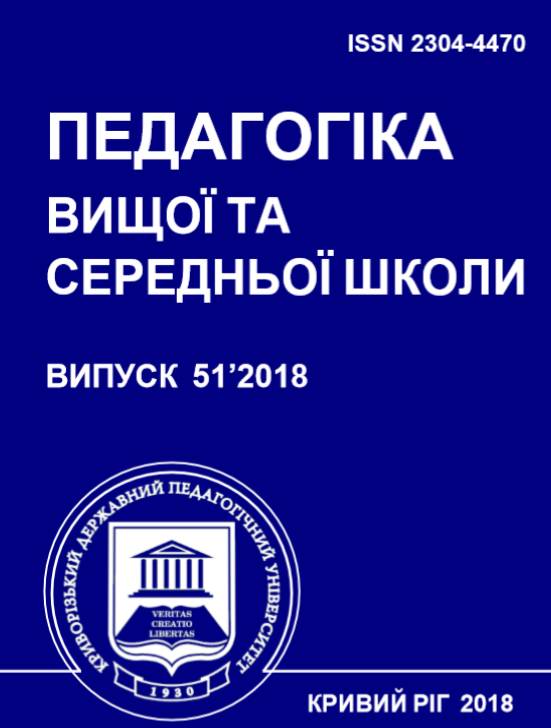Developing of Key Competencies by Means of Augmented Reality at CLIL Lessons
DOI:
https://doi.org/10.31812/pedag.v51i0.3656Keywords:
Augmented Reality, Science Learning, Key Competencies, Generation Z, Content and Language Integrated Learning (CLIL)Abstract
Merzlykin O.V., Topolova I. Yu. and V.V. Tron Developing of Key Competencies by Means of Augmented Reality at CLIL Lessons.
Using of new learning and IC technologies is necessary for effective learning of modern students. Their specific educational needs are: using of mobile ICTs, collaboration, challenging tasks and entertainment. Appropriate learning environment should be created to satisfy all these demands. It ought to deal with cloud-based technologies (for 24/7 access, individual and group work according to a personal schedule), augmented reality (for creating of firm links between real and virtual objects), content and language integrated learning (for immersion in an additional language and creation challenging groups and personal tasks in language and non-language subjects). Using these technologies in complex provides social and ICT mobility and creates positive conditions for developing 9 of 10 key competencies. The paper deals with the features, problems and benefits of technologies’ implementation in secondary schools. To sum up, in spite of all difficulties, this environment helps students to get some practical experience in using foreign languages and understanding abstract nature concepts; to develop language and research competencies and to remain motivated (and self-motivated) in learning Science and English.
Downloads
Metrics
References
Barnes & Noble College: Getting to Know Gen Z — Exploring Middle and High Schoolers’ Expectations for Higher Education. https://next.bncollege.com/wp-content/uploads/2015/10/Gen-Z-Research-Report-Final.pdf (2015). Accessed 15 Jan 2018.
Billinghurst, M., Duenser, A.: Augmented Reality in the Classroom. Computer. 45 (7), 56–63 (2012). doi: 10.1109/MC.2012.111
Cieutat, J.-M., Hugues, O., Ghouaiel, N.: Active Learning based on the use of Augmented Reality Outline of Possible Applications: Serious Games, Scientific Experiments, Confronting Studies with Creation,
Training for Carrying out Technical Skills. International Journal of Computer Applications. 46 (20), 31–36 (2012).
Coyle, D., Holmes, B., King, L.: Towards an Integrated Curriculum — CLIL National Statement and Guidelines. The Languages Company. http://www.rachelhawkes.com/PandT/CLIL/CLILnationalstatement
andguidelines.pdf (2009). Accessed 15 Jan 2018.
Diegmann P., Schmidt-Kraepelin M., Van den Eynden S., Basten D.: Benefits of Augmented Reality in Educational Environments — A Systematic Literature Review. In: Thomas, O., Teuteberg, F. (eds.) Proceedings the 12th International Conference on Wirtschaftsinformatik, Osnabrück, 4–6 March 2015, pp. 1542–1556. http://aisel.aisnet.org/wi2015/103/ (2015). Accessed 10 Jan 2018.
Exploring augmented reality : hearing before the Committee on Commerce, Science, and Transportation, United States Senate, One Hundred Fourteenth Congress, second session, November 16, 2016. U. S. Government Publishing Office, Washington (2017).
Kabinet Ministriv Ukrainy: Derzhavnyi standart bazovoi i povnoi zahalnoi serednoi osvity (The State Standard of the Basic and Complete Secondary Education). Zakonodavstvo Ukrainy. http://zakon3.rada.gov.ua/laws/show/1392-2011-%D0%BF (2011). Accessed 25 Dec 2017.
Kislova, M. A., Semerikov, S. O., Slovak, K. I.: Rozvytok mobilnoho navchalnoho seredovyshcha yak problema teorii i metodyky vykorystannia informatsiino-komunikatsiinykh tekhnolohii v osviti (Development of mobile learning environment as a problem of the theory and methods of use of information and communication technologies in education). Information Technologies and Learning Tools. 42 (4), 1–19 (2014).
Marsh, D.: CLIL/EMILE — the European dimension: actions, trends and foresight potential. University of Jyväskylä, Jyväskylä (2002).
Merzlykin, O. V., Merzlykin, P. V.: Zasoby informatsiino-komunikatsiinykh tekhnolohii pidtrymky navchalnykh doslidzhen u profilnomu navchanni fizyky (The tools of information and communication technologies for learning researches support in profile physics learning). Information Technologies and Learning Tools. 48 (4), 58–87 (2015).
Merzlykin, O. V., Semerikov, S. O.: Perspektyvni khmarni tekhnolohii v osviti (Prospective Cloud Technologies in Education). In: Proceedings of the scientific and practical workshop on Cloud Technologies in Modern University, Cherkasy, 24 Mar 2015, pp. 31–33. ChDTU, Cherkasy (2015).
Merzlykin, O. V.: Khmarni tekhnolohii yak zasib formuvannia doslidnytskykh kompetentnostei starshoklasnykiv u protsesi profilnoho navchannia fizyky (Cloud technologies as tools of high school students’
research competencies forming in profile physics learning). Thesis for the degree of candidate of pedagogical science, Institute of Information Technologies and Learning Tools of the NAPS of Ukraine (2017).
Merzlykin, O. V.: Mozhlyvosti vykorystannia Google Classroom dlia realizatsii khmarnoho seredovyshcha pidtrymky navchalnykh doslidzhen z fizyky (The possibilities of using Google Classroom for implementing cloud environment of support physics learning researches). In: Proceeding of the 2nd Ukrainian scientific and practical conference of young scientists “Scientific Youth–2014”, pp. 110–112. Institute of Information Technologies and Learning Tools of the NAES of Ukraine, Kyiv (2014).
Modlo, E. O., Echkalo, Yu. V., Semerikov, S. O., Tkachuk, V. V.: Vykorystannia tekhnolohii dopovnenoi realnosti u mobilno oriientovanomu seredovyshchi navchannia VNZ (Using technology of augmented reality in a mobile-based learning environment of the higher educational institution). Naukovi zapysky, Seriia: Problemy metodyky fizyko-matematychnoi i tekhnolohichnoi osvity. 11 (1), 93–100 (2017).
Roesner, F., Kohno, T., Molnar, D.: Security and Privacy for Augmented Reality Systems. Communications of The ACM. 57 (4), 88–96 (2014). doi: 10.1145/2580723.2580730
Rosenberg, L. B.: The Use of Virtual Fixtures As Perceptual Overlays to Enhance Operator Performance in Remote Environments: Interim Report for The Period June 1992 to July 1992. Wright-Patterson Air Force Base, Ohio (1992).
Semerikov, S. O., Striuk, A. M., Slovak, K. I., Rashevska, N. V., Yechkalo, Yu. V.: Liudyna z kompiuternym oblychchiam (do 80-richchia Aivena Edvarda Sazerlenda) (A man with a computer face (to the 80th
anniversary of Ivan Edward Sutherland)). New computer technology. 16, 9–24 (2018).
Sutherland, I. E.: The Ultimate Display. In: Proceedings of the IFIP Congress 1965. New York City, 24–29 May 1965, vol. 2, pp. 506–508. Macmillan and Co., London (1965).
Technology Research & Insight for IT Professionals | Gartner Inc. https://www.gartner.com/technology/it_professionals.jsp (2018). Accessed 26 Jan 2018.
Teplytskyi, I. O., Semerikov, S. O., Polishchuk, O. P.: Model mobilnoho navchannia v serednii ta vyshchii shkoli (The model of mobile learning in middle and high school). In: Proceedings of the 3rd Ukrainian scientific and methodical workshop on Computer Simulation in Education, Kryvyi Rih, 24 Apr 2008, pp. 45–46. KDPU, Kryvyi Rih (2008).
Downloads
Published
How to Cite
Issue
Section
License
Copyright (c) 2018 Олександр Мерзликін, Ірина Тополова, Віталій Тронь

This work is licensed under a Creative Commons Attribution 4.0 International License.









